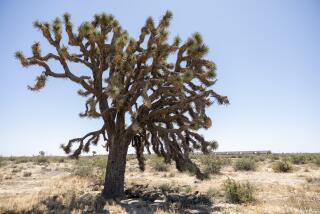Lujan Impressed by Plan to Dye Mine Tailings
SODA SPRINGS, Calif. — Interior Secretary Manuel Lujan Jr., touring the California desert, said here Friday that he was favorably impressed with a proposed mine’s plan to restore the desert landscape site by eventually dyeing the mined rock dark brown “to give it a natural look.”
“I was very impressed with what they say is their reclamation effort--using dye to give it a natural look,” Lujan said, referring to the desert setting that is part of a proposed national park.
The Interior secretary, after visiting the mine site, came to this lonely patch of desert about 60 miles north of Barstow to unveil a plaque for a nature center. In a brief interview after the ceremony, he stopped short of endorsing the controversial Viceroy Gold Mine, which is undergoing an environmental review, saying he would need to study the proposal further.
But he added: “At least from what I saw, it looked good to me.”
The 900-acre mine would sit in the Castle Mountains in the eastern Mojave Desert, about 100 miles south of Las Vegas, in a National Scenic Area managed by the Interior Department’s Bureau of Land Management. The site would become a new national park under legislation sponsored by Sen. Alan Cranston (D-Calif.).
Environmental groups have strongly criticized the proposed mine, arguing that it would deface the desert and threaten wildlife. A group of Canadian investors who have proposed the facility said the site would be cleaned up and returned as much as possible to its natural state.
A Bureau of Land Management official said the dye that Lujan referred to is actually an iron-based solution that, when applied to rock exposed to sunlight, will stain it the brown color of desert topsoil.
Disheartened by Comments
Elden Hughes, director of the California Desert Protection League, was disheartened by Lujan’s comments.
“Just painting the trash doesn’t do the job,” said Hughes, who attended the plaque-unveiling ceremony. “They (the investors) haven’t done near enough. They ought to make the mountain whole. They are going to leave behind all the tailings.”
But Howard W. Dare, president of the United Mining Councils of America, liked what he heard from Lujan.
“I think he’ll be better than any (Interior secretary) we’ve had,” said Dare, who came to meet Lujan. “I feel it seriously. He seems like he is all-man. You can talk to him easily.”
The technology that would be employed to mine the site uses cyanide to extract the gold. Ore dug from strip mines is saturated with a weak cyanide solution, which is then diverted to collecting ponds. In Nevada, more than 6,400 migratory birds and other animals, including deer, coyotes, kit foxes and rabbits, have been killed by drinking from such cyanide-laced ponds at mines since 1984, according to Nevada officials.
But in California, the Bureau of Land Management has counted fewer than 50 dead birds and mammals near such mines in the last two years. BLM officials say most of the California mines employ floating covers, air cannons or strings of multicolored flags to ward off thirsty animals--devices the Viceroy mine would also employ. Environmentalists contend that the safeguards often fail and worry that accidental cyanide spills may also endanger animals.
Although Lujan seemed satisfied with Viceroy’s plans, he expressed sympathy for those who want to limit mining in the desert.
“That’s always tough because it (the land) doesn’t look too good afterwards,” he said.
Lujan said he has not decided whether the proposed mining site is deserving of national park status, nor has he reached a position on giving Death Valley and Joshua Tree national monuments the added environmental protection of national park status as called for in Cranston’s bill.
But he expressed optimism that the BLM would be able to reach a compromise with Cranston over granting wilderness status to millions of acres of federal land. The BLM has proposed adding 1.7 million acres in the desert for wilderness protection, which would mean prohibiting more development in the areas. Cranston wants to give wilderness protection to about 4 million acres.
More to Read
Sign up for Essential California
The most important California stories and recommendations in your inbox every morning.
You may occasionally receive promotional content from the Los Angeles Times.











